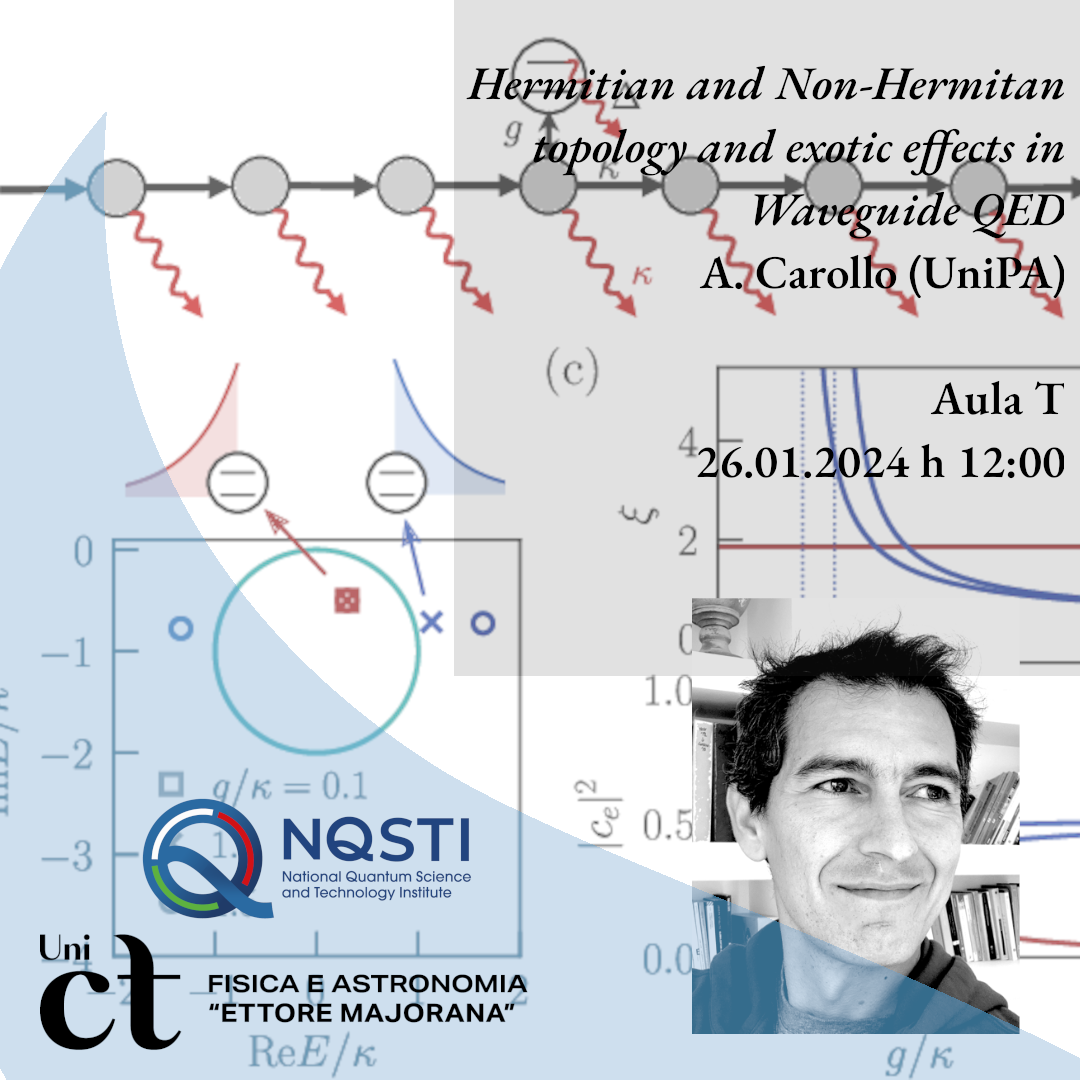Hermitian and Non-Hermitan topology and exotic effects in Waveguide QED

Giorno 26 gennaio 2024, con inizio alle ore 12:00, presso l'Aula T del DFA, il Prof. Angelo Carollo (Università di Palermo) terrà un seminario dal titolo Hermitian and Non-Hermitan topology and exotic effects in Waveguide QED.
L'evento è proposto dal Prof. G. Falci nel quadro della ricerca del National Quantum Science and Technology Institute (NQSTI).
Tutte le persone interessate sono invitate a partecipare.
Abstract. As light can mediate interactions between atoms in a photonic environment, engineering it for endowing the photon-mediated Hamiltonian with desired features is crucial in quantum research.
In the first part of the talk I will discuss exotic properties of interactions mediated by non- Hermitian reservoirs, made of lossy photonic lattices. I will show in a paradigmatic case study that when these losses are suitably structured, exotic emission properties can be observed. Photons can mediate dissipative, fully non-reciprocal, interactions between the emitters with range critically dependent on the loss rate. Counter-intuitively, this occurs irrespective of the lattice boundary conditions. Thus photons can mediate an effective emitters’ Hamiltonian which is translationally-invariant despite the fact that the field is not.
In the second part of the talk I will introduce general theorems on the topology of photon-mediated interactions in terms of both Hermitian and non-Hermitian topological invariants, unveiling the phenomena of topological preservation and reversal, and revealing a system-bath topological correspondence. Depending on the Hermiticity of the environment and the parity of the spatial dimension, the atomic and photonic topological invariants turn out to be equal or opposite. Consequently, the emergence of atomic and photonic topological boundary modes with opposite group velocity in two-dimensional Hermitian topological systems is established. Owing to its general applicability, these results can guide the design of Hermitian and Non-Hermitian topological systems.
References.
- Roccati, F.; Bello,M.; Gong, Z.; Ueda, M.; Ciccarello ,F.; Chenu, A.; Carollo, A. Hermitian and Non-Hermitian Topology from Photon-Mediated Interactions. 2023 arXiv:2303.00762
- Roccati, F.; Lorenzo, S.; Calajò, G.; Palma, G.M.; Carollo, A.; Ciccarello, F. Exotic Interactions Mediated by a Non-Hermitian Photonic Bath. Optica 2022, 9, 565, doi:10.1364/optica.443955
- Leonforte, L.; Valenti, D.; Spagnolo, B.; Carollo, A.; Ciccarello, F. Dressed Emitters as Impurities. Nanophotonics 2021, 10, 4251–4259, doi:10.1515/nanoph-2021-0490
- Leonforte, L.; Carollo, A.; Ciccarello, F. Vacancy-like Dressed States in Topological Waveguide QED. Phys. Rev. Lett. 2021, 126, 063601, doi:10.1103/PhysRevLett.126.063601
Bio. Angelo Carollo completed his PhD in quantum optics and quantum information in 2004 at Imperial College London, under the supervision of Vlatko Vedral. He has been a postdoctoral fellow in at the University of Cambridge under Artur Ekert and a Marie Curie fellow at the University of Innsbruck under Peter Zoller. After an experience in the financial industry in London, he joined the University of Palermo in 2010 as a research fellow where he is now Associate Professor. His current research interests range from Hermitian and non-Hermitian topological properties in condensed matter and quantum optics, to quantum metrology, and equilibrium and non-equilibrium quantum statistical physics.